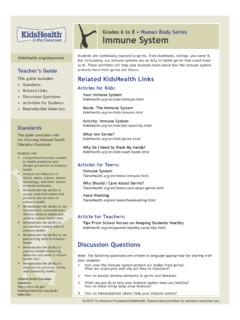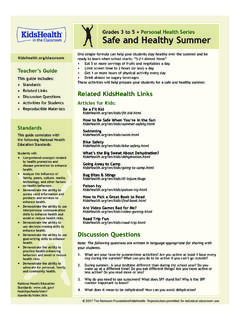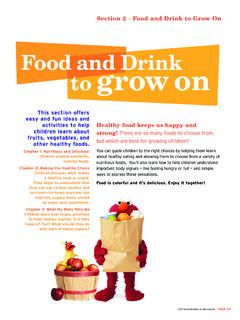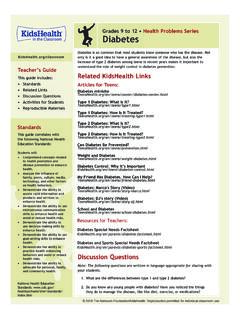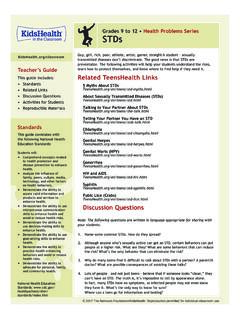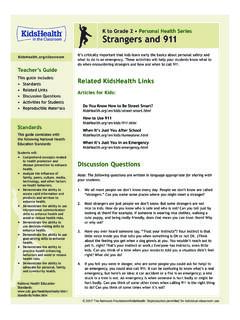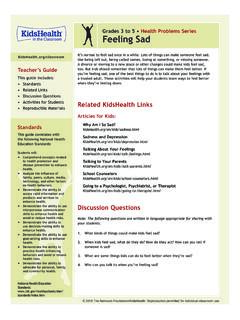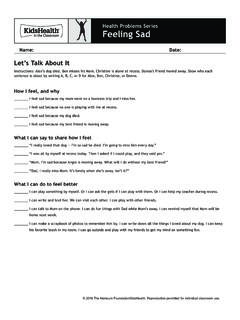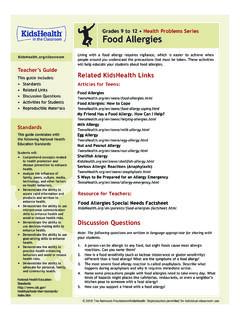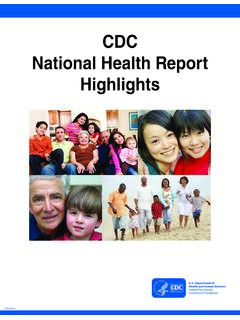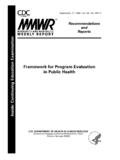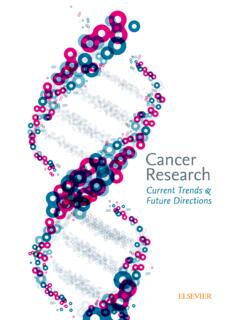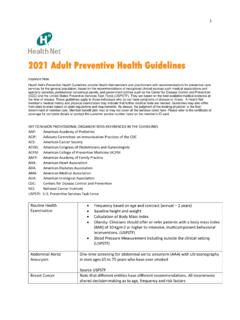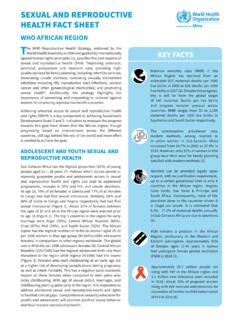Transcription of Teacher's Guide: STDs (Grades 6 to 8) - KidsHealth
1 2017 The Nemours Foundation/ KidsHealth . Reproduction permitted for individual classroom 6 to 8 Health Problems SeriesSTDsAbout million teens and young adults are diagnosed with sexually transmitted diseases (STDs) each year, according to the Department of Health and Human Services. The good news is that these infections are preventable. The following activities will help your students understand the risks and how to protect TeensHealth LinksDiscussion QuestionsNote: The following questions are written in language appropriate for sharing with your does the STD or STI stand for?
2 What kinds of STDs have you heard of? do STDs affect? Can you tell just by looking if someone has an STD? STDs are such an important teen health problem, why don t we hear aboutthem as much as smoking, drinking, or drugs? are STDs spread? s only one 100% effective way for teens to protect themselves from anSTD, and that s abstinence (no sexual contact). But even teens who are sexuallyactive can take steps to lower their risk. What can they do?Teacher s GuideThis guide includes: Standards Related Links Discussion Questions Activities for Students Reproducible MaterialsStandardsThis guide correlates with the following National Health Education Standards:Students will: Comprehend concepts relatedto health promotion anddisease prevention to enhancehealth.
3 Analyze the influence offamily, peers, culture, media,technology, and other factorson health behaviors. Demonstrate the ability toaccess valid information andproducts and services toenhance health. Demonstrate the ability to useinterpersonal communicationskills to enhance health andavoid or reduce health risks. Demonstrate the ability touse decision-making skills toenhance health. Demonstrate the ability to usegoal-setting skills to enhancehealth. Demonstrate the ability topractice health-enhancingbehaviors and avoid or reducehealth risks. Demonstrate the ability toadvocate for personal, family,and community Myths About STDs Sexually Transmitted Diseases (STDs) to Your Partner About STDs Telling Your Partner You Have an Herpes Warts (HPV) and AIDS Lice (Crabs) Health Education Standards: 2017 The Nemours Foundation/ KidsHealth .
4 Reproduction permitted for individual classroom for StudentsNote: The following activities are written in language appropriate for sharing with your FactsheetsObjectives:Students will: Learn what STDs are and behaviors that can put people at risk Demonstrate their understanding of various STDs by researching and creating factsheetsMaterials: Magazine, six index cards, scissors, tape "STD Factsheet" handout "Parent Letter" handout Class Time: 90 minutes (45 minutes to research, 45 minutes to present)Activity:[Note to instructor: To prepare, cut out six pictures of people (not celebrities) from magazines.]
5 Choose people of both genders and various ethnicities and ages. They may be rich or poor, healthy- or unhealthy-looking, dressed conservatively or flashy. On the back of each picture, tape an index card with one of the following words: chlamydia, HIV/AIDS, genital herpes, gonorrhea, genital warts, and syphilis. Hang the pictures on the board. Then divide the class into six groups.] Good morning and welcome to your new job! Today you ll be acting as interns for a community health clinic. These people on the board are your patients. They ve all come in for the results of their STD tests.
6 Can you guess who tested positive? Do the pictures give you any clue?Let s have one representative from each group come up, choose a picture, and read what s on the back. The first fact about STDs? They don t discriminate! Working as a group, your job is to create a factsheet about your patient s STD that he or she can take home today. Include as much information as you can, using articles at for research. Afterward, each group will present what they learned. a personal note to your patient explaining why it was a smart decision to get a brief reflection essay about how your idea of the type of person who gets an STD may have the six factsheets into a packet and photocopy them for each student.
7 Send packet home to parents or guardians, with the "Parent Letter" handout, to encourage discussions at home. grades 6 to 8 Health Problems SeriesSTDs 2017 The Nemours Foundation/ KidsHealth . Reproduction permitted for individual classroom is devoted to providing the latest children s health information. The site, which is widely recommended by educators, libraries, and school associations, has received the Teachers Choice Award for the Family and the prestigious Pirelli Award for Best Educational Media for Students. KidsHealth comes from the nonprofit Nemours Foundation.
8 Check out to see the latest additions!STD IQObjectives:Students will: Test their knowledge of STDs by playing a true-or-false gameMaterials: "STD IQ" handouts Class Time: 1 hourActivity:[Note to instructor: You can divide your class into pairs or teams to quiz themselves with the two 20-statement STD IQ handouts, or just go around the room asking the true-false questions yourself.] True or false: There are a thousand other things you d rather talk about than STDs. True, right? But knowing the facts about STDs is one of the most important things teens can do for their health.
9 There s a lot of misinformation out there, and it s difficult to make good decisions with bad information. So here s your chance to test your STD IQ. Extension:Create a Did You Know? PSA poster depicting the most surprising fact you learned from this MaterialsHandout: STD Factsheet : Parent Letter : STD IQ 1 : STD IQ 1 Answer Key : STD IQ 2 : STD IQ 2 Answer Key : STDs Key: STDs 6 to 8 Health Problems SeriesSTDs 2017 The Nemours Foundation/ KidsHealth . Reproduction permitted for individual classroom : Date:Personal Health SeriesSTDsSTD:What It Is:How It s Spread:Symptoms:Treatment:Prevention:Whe re to Get Help:STD Factsheet 2017 The Nemours Foundation/ KidsHealth .
10 Reproduction permitted for individual classroom Health SeriesSTDsDear,In class, we recently discussed sexually transmitted diseases (STDs): what they are, how they are spread, and how they can be prevented. I hope you ll use this as an opportunity to continue to talk to your child about this important health topic. offers resources to help with family discussions. Sincerely,Date: For parents: For teens: Letter 2017 The Nemours Foundation/ KidsHealth . Reproduction permitted for individual classroom : Date:Personal Health SeriesSTDsInstructions: Mark the True or False box for each statement.
